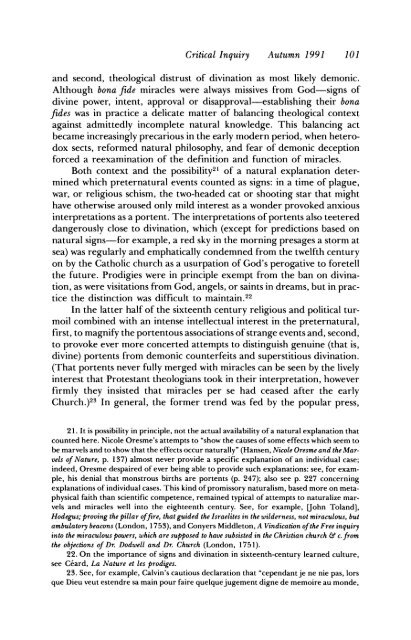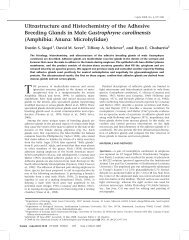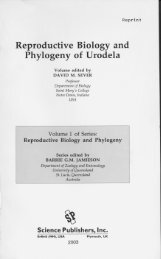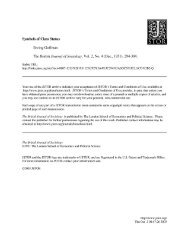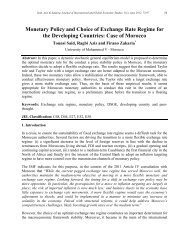Marvelous Facts and Miraculous Evidence in Early Modern Europe ...
Marvelous Facts and Miraculous Evidence in Early Modern Europe ...
Marvelous Facts and Miraculous Evidence in Early Modern Europe ...
You also want an ePaper? Increase the reach of your titles
YUMPU automatically turns print PDFs into web optimized ePapers that Google loves.
Critical Inquiry<br />
Autumn 1991<br />
101<br />
<strong>and</strong> second, theological distrust of div<strong>in</strong>ation as most likely demonic.<br />
Although bona fide miracles were always missives from God-signs of<br />
div<strong>in</strong>e power, <strong>in</strong>tent, approval or disapproval-establish<strong>in</strong>g their bona<br />
fides was <strong>in</strong> practice a delicate matter of balanc<strong>in</strong>g theological context<br />
aga<strong>in</strong>st admittedly <strong>in</strong>complete natural knowledge. This balanc<strong>in</strong>g act<br />
became <strong>in</strong>creas<strong>in</strong>gly precarious <strong>in</strong> the early modern period, when heterodox<br />
sects, reformed natural philosophy, <strong>and</strong> fear of demonic deception<br />
forced a reexam<strong>in</strong>ation of the def<strong>in</strong>ition <strong>and</strong> function of miracles.<br />
Both context <strong>and</strong> the possibility2l of a natural explanation determ<strong>in</strong>ed<br />
which preternatural events counted as signs: <strong>in</strong> a time of plague,<br />
war, or religious schism, the two-headed cat or shoot<strong>in</strong>g star that might<br />
have otherwise aroused only mild <strong>in</strong>terest as a wonder provoked anxious<br />
<strong>in</strong>terpretations as a portent. The <strong>in</strong>terpretations of portents also teetered<br />
dangerously close to div<strong>in</strong>ation, which (except for predictions based on<br />
natural signs-for example, a red sky <strong>in</strong> the morn<strong>in</strong>g presages a storm at<br />
sea) was regularly <strong>and</strong> emphatically condemned from the twelfth century<br />
on by the Catholic church as a usurpation of God's perogative to foretell<br />
the future. Prodigies were <strong>in</strong> pr<strong>in</strong>ciple exempt from the ban on div<strong>in</strong>ation,<br />
as were visitations from God, angels, or sa<strong>in</strong>ts <strong>in</strong> dreams, but <strong>in</strong> practice<br />
the dist<strong>in</strong>ction was difficult to ma<strong>in</strong>ta<strong>in</strong>.22<br />
In the latter half of the sixteenth century religious <strong>and</strong> political turmoil<br />
comb<strong>in</strong>ed with an <strong>in</strong>tense <strong>in</strong>tellectual <strong>in</strong>terest <strong>in</strong> the preternatural,<br />
first, to magnify the portentous associations of strange events <strong>and</strong>, second,<br />
to provoke ever more concerted attempts to dist<strong>in</strong>guish genu<strong>in</strong>e (that is,<br />
div<strong>in</strong>e) portents from demonic counterfeits <strong>and</strong> superstitious div<strong>in</strong>ation.<br />
(That portents never fully merged with miracles can be seen by the lively<br />
<strong>in</strong>terest that Protestant theologians took <strong>in</strong> their <strong>in</strong>terpretation, however<br />
firmly they <strong>in</strong>sisted that miracles per se had ceased after the early<br />
Church.)23 In general, the former trend was fed by the popular press,<br />
21. It is possibility <strong>in</strong> pr<strong>in</strong>ciple, not the actual availability of a natural explanation that<br />
counted here. Nicole Oresme's attempts to "show the causes of some effects which seem to<br />
be marvels <strong>and</strong> to show that the effects occur naturally" (Hansen, Nicole Oresme <strong>and</strong> the Marvels<br />
of Nature, p. 137) almost never provide a specific explanation of an <strong>in</strong>dividual case;<br />
<strong>in</strong>deed, Oresme despaired of ever be<strong>in</strong>g able to provide such explanations: see, for example,<br />
his denial that monstrous births are portents (p. 247); also see p. 227 concern<strong>in</strong>g<br />
explanations of <strong>in</strong>dividual cases. This k<strong>in</strong>d of promissory naturalism, based more on metaphysical<br />
faith than scientific competence, rema<strong>in</strong>ed typical of attempts to naturalize marvels<br />
<strong>and</strong> miracles well <strong>in</strong>to the eighteenth century. See, for example, [John Tol<strong>and</strong>],<br />
Hodegus; prov<strong>in</strong>g the pillar offire, that guided the Israelites <strong>in</strong> the wilderness, not miraculous, but<br />
ambulatory beacons (London, 1753), <strong>and</strong> Conyers Middleton, A V<strong>in</strong>dication of the Free <strong>in</strong>quiry<br />
<strong>in</strong>to the miraculous powers, which are supposed to have subsisted <strong>in</strong> the Christian church & c. from<br />
the objections of Dr. Dodwell <strong>and</strong> Dr. Church (London, 1751).<br />
22. On the importance of signs <strong>and</strong> div<strong>in</strong>ation <strong>in</strong> sixteenth-century learned culture,<br />
see Ceard, La Nature et les prodiges.<br />
23. See, for example, Calv<strong>in</strong>'s cautious declaration that "cependantje ne nie pas, lors<br />
que Dieu veut estendre sa ma<strong>in</strong> pour faire quelquejugement digne de memoire au monde,


